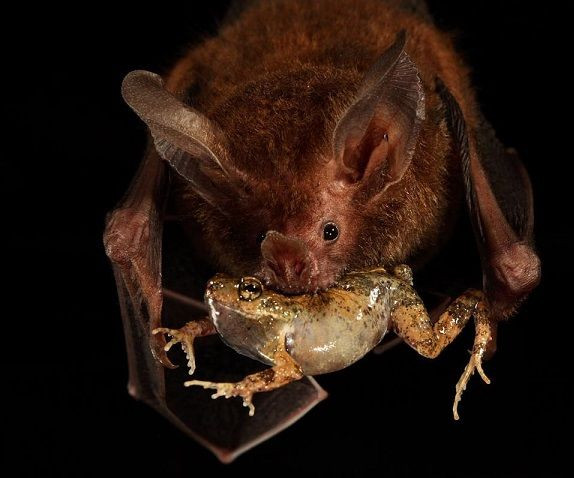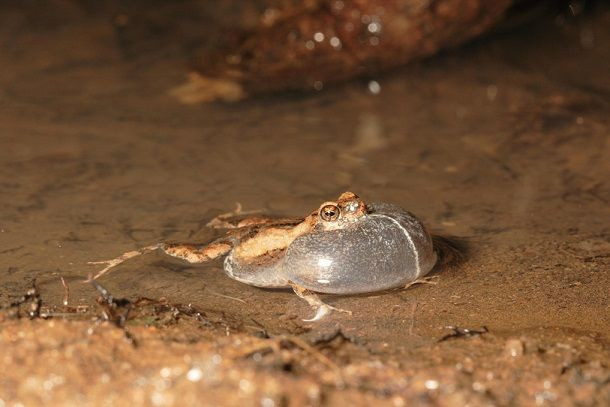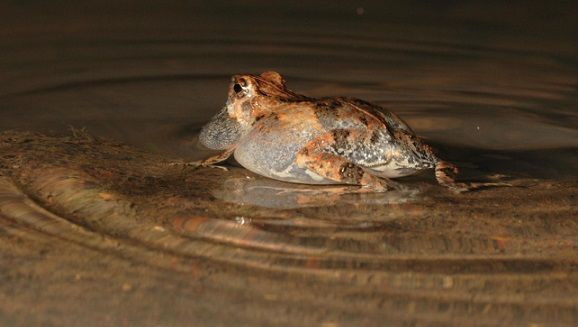Bats Follow Ripples In Ponds Back To Croaking Frogs [PHOTOS]

A male tungara frog’s come-hither croak can attract the interest of a female – or a leathery-winged predator.

On late nights, in pools and ponds across South America, male tungara frogs vie to woo females. Each frog maintains a small domain in a shallow puddle from which he inflates his air sac, and croaks his little heart out. The sound is actually something a little less like a croak and a little more like a car alarm:
If he’s lucky, the male will find a nice girl frog he can help build a foam nest to house their babies. The happy couple will use their feet to mold the fluids that come out of the female’s cloaca to create a safe basket for the fertilized eggs.
But there’s trouble lurking in frog paradise, in the form of Trachops cirrhosis, the frog-eating fringe-lipped bat. Researchers from the Smithsonian Tropical Research Institute, the University of Texas at Austin, Leiden University and Salisbury University say they’ve found an unexpected way that the tungara frog’s amorous croaks inadvertently attract attention from the bats: ripples.

As the frog inflates and deflates his air sac, he disturbs the surface of the puddle he’s squatting in, sending out ripples (which travel about 25 centimeters every second, the scientists say). If the frog senses that a bat’s nearby, he’ll stop croaking – but there’s still a trail leading back to him through the water.
“Ripples leave a ‘footprint’ of the frog’s presence for several seconds” after the frog ceases to croak, the authors wrote in a study published on Thursday in the journal Science.
But can the bats really use their echolocation skills to spot the ripples that lead back to the froggy bulls-eye? It certainly looks like they can, according to the team’s experiments. Given the choice between a frog-like target that emits both frog calls and ripples versus one that just makes frog noises, the bats will tend to attack the former, the researchers found.
"The interesting thing is that these frogs have evolved a strategy to escape predation," lead author Wouter Halfwerk, a postdoctoral researcher at UT Austin and also affiliated with STRI and Leiden University. "When a frog detects the shadow of a bat overhead, his first defense is to stop calling immediately. Unfortunately for the frog, the water ripples created by his call do not also stop immediately. The ripples continue to emanate out for several seconds, creating a watery bull's-eye on the frog. Bats use the ripples, thereby beating the anti-predator strategy."
The team has also found that ripples accompanying a tungara frog’s call will also spur his rivals to croak louder than the noise by itself.
If a frog wants to croak safely, he might be well-advised to seek out areas of a pond that are cluttered with leaf litter and other material – this stuff helps keep the ripples from spreading out and betraying his presence, the scientists say.
The find underscores just what a dangerous game mating is in the natural world.
“All signals and associated byproducts produce disturbances in the environment… exposing the signalers to a complex array of costs and benefits,” the authors wrote.
SOURCE: Halfwerk et al. “Risky Ripples Allow Bats and Frogs to Eavesdrop on a Multisensory Sexual Display.” Science 343: 413-416, 24 January 2014.
© Copyright IBTimes 2024. All rights reserved.





















